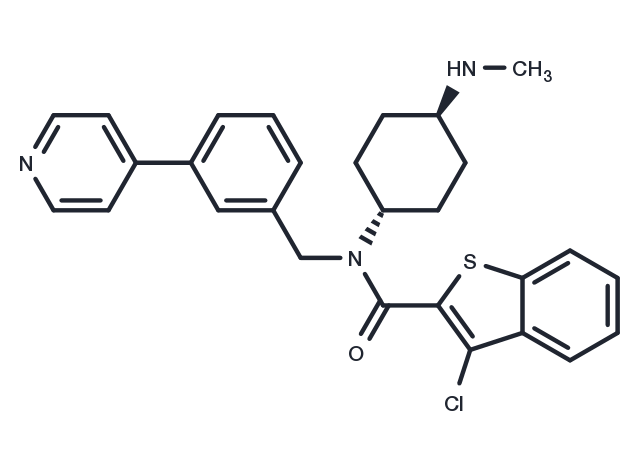Powder: -20°C for 3 years | In solvent: -80°C for 1 year
SAG (Smoothened Agonist) is a Smo receptor agonist (EC50=3 nM) that is cell-permeable and selective. SAG regulates Smo activity by binding directly to the Smo helix and can activate the Hedgehog signaling pathway.

| 説明 | SAG (Smoothened Agonist) is a Smo receptor agonist (EC50=3 nM) that is cell-permeable and selective. SAG regulates Smo activity by binding directly to the Smo helix and can activate the Hedgehog signaling pathway. |
| ターゲット&IC50 | Smo:3 nM(EC50) |
| In vitro |
METHODS: Embryonic stem cell ES were treated with SAG (0.5-1.25 µM) for 4-6 days and gene expression levels were measured using RT-qPCR. RESULTS: Expression of Sim1, a post-mitotic V3 marker, was increased in all SAG-treated groups at all concentrations. The group treated with 0.5 μM SAG exhibited significantly higher levels of Nkx2.2 mRNA. Hb9 expression did not change significantly with SAG concentration at the given time points. [1] METHODS: African green monkey kidney fibroblast-like cells, Cos-1, were treated with SAG (5-500 nM), and target protein expression levels were measured by Western Blot. RESULTS: SAG inhibited cross-linking of ER-localized and post-ER forms of Smo-Myc3 to 125I-labeled PA cyclic amines in Cos-1 cells in a dose-dependent manner. cellular levels of Smo-Myc3 were not affected by agonist treatment. [2] |
| In vivo |
METHODS: To explore whether the SHH signaling pathway plays a protective role in anxiety by regulating mitochondrial homeostasis, SAG (10 mg/kg) was intraperitoneally injected into C57BL/6 mice on a high-fat diet every three days for twelve weeks. RESULTS: SHH signaling is neuroprotective in obesity, and SAG alleviates anxiety-like behaviors by reducing mitochondrial breaks. [3] METHODS: To study the effects on developing limbs, SAG (15-20 mg/kg in lactated Ringer's solution) was administered as a single intraperitoneal injection to pregnant C57BL/6J mice at gestational day (GD) 9.25. RESULTS: The most prevalent effect of SAG was the dose-dependent induction of preaxial polydactyly; defects ranged from thumb width to duplication of both digitiform fingers on the preaxial side of the thumb. [4] |
| キナーゼ試験 | In vitro Kinase Assays: Kinase assays for CDK1, CDK2 and GSK3-β are all carried out in a radiometric filter binding format. Assays for CDK5 are in DELFIA format and for CDKs 4 and 6 in ELISA format. For CDKs 1 and 2, the relevant CDK and 0.12 μg/mL Histone H1 are incubated in 20 mM MOPS, pH 7.2, 25 mM β-glycerophosphate, 5 mM EDTA, 15 mM MgCl2, 1 mM sodium orthovanadate, 1 mM DTT, 0.1 mg/mL BSA, 45 μM ATP (0.78 Ci/mmol) and different concentrations of AT7519 for 2 or 4 hours respectively. For GSK3-β, the relevant enzyme and 5 μM glycogen synthase peptide 2 along with 10 mM MOPS pH 7.0, 0.1 mg/mL BSA, 0.001% Brij-35, 0.5% glycerol, 0.2 mM EDTA, 10 mM MgCl2, 0.01% β-mercaptoethanol, 15 μM ATP (2.31 Ci/mmol) and different concentrations of AT7519 are incubated for 3 hours. Assay reactions are stopped by adding an excess of orthophosphoric acid and filtered using Millipore MAPH filter plates. The plates are then washed, scintillant added and radioactivity measured by scintillation counting on a Packard TopCount. For CDK5, CDK5/p35 and 1 μM of a biotinylated Histone H1 peptide (Biotin-PKTPKKAKKL) are incubated in 25 mM Tris-HCl, pH 7.5, 2.5 mM MgCl2, 0.025% Brij-35, 0.1 mg/mL BSA, 1 mM DTT, 15 μM ATP and different concentrations of AT7519 for 30 minutes. Assay reactions are stopped using EDTA, transferred to Neutravidin-coated plates and phosphorylated peptide quantified by means of a rabbit phospho-cdk1 substrate polyclonal antibody and DELFIA europium-labelled anti-rabbit IgG secondary antibody using time-resolved fluorescence at λex=335 nM, λem=620 nM. For CDK 4 and 6 assays, plates are coated with GST- pRb769-921 and blocked with Superblock. CDK4 or 6 is incubated with 15 mM MgCl2, 50 mM HEPES, pH 7.4, 1 mM DTT, 1 mM EGTA, pH 8.0, 0.02% Triton X-100, 2.5% DMSO and different concentrations of AT7519; the reaction is initiated by addition of ATP. After 30 minutes, reactions are stopped by the addition of 0.5 M EDTA pH 8.0.Plates are then washed and incubated for one hour with the primary antibody (anti- p-Rb Serine 780) diluted in Superblock followed by secondary antibody (alkaline phosphatase linked anti-rabbit) for a further hour. Plates are developed using the Attophos system and fluorescence read on a Spectramax Gemini plate reader at excitation 450 nm and emission 580 nm. In all cases, IC50 values are calculated from replicate curves, using GraphPad Prism software. |
| 別名 | Smoothened Agonist (SAG) HCl, Smoothened Agonist |
| 分子量 | 490.06 |
| 分子式 | C28H28ClN3OS |
| CAS No. | 912545-86-9 |
Powder: -20°C for 3 years | In solvent: -80°C for 1 year
DMSO: 71 mg/mL (134.84 mM), Heating is recommended.
Ethanol: 40 mg/mL (75.97 mM), Heating is recommended.
You can also refer to dose conversion for different animals. 詳細
bottom
Please see Inhibitor Handling Instructions for more frequently ask questions. Topics include: how to prepare stock solutions, how to store products, and cautions on cell-based assays & animal experiments, etc.
SAG 912545-86-9 GPCR/G Protein Stem Cells Hedgehog/Smoothened Smo Smoothened Agonist (SAG) HCl inhibit Smoothened Inhibitor Smoothened Agonist inhibitor
